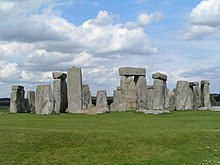monument

A monument (from Latin monere remember; monumentum monument) is an important or important monument of large dimensions. In general, this can be a natural, distinctive landmark , a man-made structure , a picture or a painting .
Meaning and differences
In particular, a monument should permanently preserve the memory of historically significant people or events.
A monument can generally be understood as any monumental reminder, from a raised hill (for example a tumulus ) or stone ( megalith , monolith or menhir ) to a completed work of art. An example of this is Stonehenge .
A distinction is made between tombs ( cenotaphs ), cenotaphs , memorials , memorials and memorials. War memorials and triumphal arches to commemorate a military victory or to commemorate the dead, such as the Völkerschlachtdenkmal in Leipzig , often play a special monumental role .
For their part, tombstones can be designed as mausoleums and burial mounds as resting places of the deceased (e.g. the pyramids of Giza ), obelisks , steles , epitaphs ( tombstones ) (smaller monuments of a deceased).
Monuments for events consist of inscriptions , reliefs , allegorical figures, obelisks , columns , triumphal arches , votive temples , votive churches , often also in monumental images .
history
Antiquity
The most famous, oldest and most widespread monuments are the tombs. Cenotaphs for individuals, initially ideal statues , later portrait statues , were common among the ancient Greeks and Romans (such as the tomb of Eurysaces in Rome). The victorious statues erected in Olympia formed a special genre . For practical reasons, portrait statues were kept in stock so that they could be fitted with the head made to order afterwards.
middle Ages
In the Middle Ages , this type of monument was less common. These include special works of art such as the Magdeburg rider Emperor Otto I and the Bamberg rider King Konrad III. in Bamberg Cathedral.
Renaissance
In the age of the Renaissance they came into use again, but initially only for rulers or generals, which nonetheless gave rise to general criticism (equestrian statue of Gattamelata in Padua and Colleoni in Venice); the costs were borne by the honorees themselves.
19th century
In the 19th century, monumentality spread, depending on the importance of the person to be honored or the resources available, in inscription panels , portrait medallions , busts , seated or standing portrait statues , equestrian statues or groups of statues .
In Germany, the Bavaria in Munich, the Walhalla near Regensburg, the Liberation Hall near Kelheim, the Luther Monument (Worms) , the Hermann Monument in the Teutoburg Forest, the Victory Column in Berlin and the Germania on the Niederwald were built. In France the Arc de Triomphe , Paris, in Rome the Monumento Vittorio Emanuele II , in the USA the Washington Monument or the Statue of Liberty in New York .
Modern times
In the 20th century, landscape-defining buildings like the Empire State Building in New York were considered monumental. The dimensions of monumental sculptures reached gigantic proportions, especially in the USA ( Mount Rushmore National Memorial , Crazy Horse Memorial ). An example of a monument in contemporary art is the sculpture END by Gregor Schneider .
Monuments of a warning character were dedicated to commemorating historical events that shaped the 20th century, such as the atomic bomb dome (1945) in Hiroshima, the Buchenwald Monument (1958) in Weimar, or the Memorial to the Murdered Jews of Europe (2005) in Berlin.




